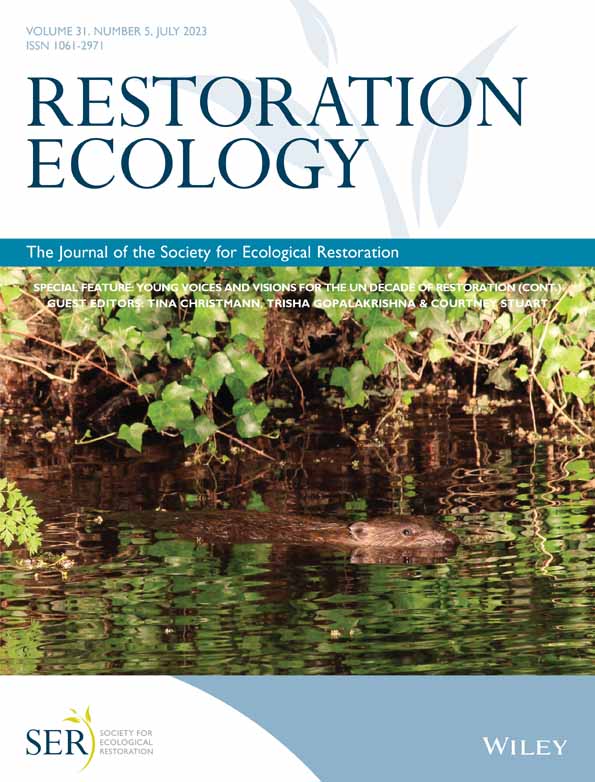Understanding movement and habitat-use to guide reintroductions and habitat rehabilitation for a nonmigratory freshwater fish
Author contributions: JO, RA, FA, WK, AK, TC, MB contributed to project methodology; JO, RA, FA, WK, AK, TC, MB contributed to data collection; JM, JO, RH analyzed the data; JO, RH, JM led the writing of the manuscript; all authors reviewed drafts and gave approval for publication.
Abstract
Outcomes from restoration and reintroduction programs can be enhanced by understanding the habitat use of animals, and how likely they are to move and why? River blackfish are native to southeastern Australia where their range and abundance have declined. We reintroduced 27 river blackfish into two sites, one where rehabilitation had been undertaken (with more vegetation, instream woody habitat, and undercut banks) and an unmanipulated control site. We monitored fish for 9 months after release to assess site occupancy, habitat use, and drivers of movement. We modeled the likelihood of fish remaining at either site, their habitat use, and predictors of movement (site type, habitat, time, and river discharge). While more fish remained at the treatment site, this difference was not statistically significant. Future trials incorporating increased numbers of fish and replicate treatment and control release sites would allow a more detailed test of whether fish are more likely to remain at restored sites. Fish spent more time in deeper areas with more riparian vegetation. Habitat, flow, and time since release were significant predictors of fish movement, with fish more likely to move from release sites with less suitable habitat, during rainfall events, and during the initial stages of our study. Our results illustrate that blackfish are a suitable candidate for translocations, retaining their largely sedentary behavior and should be easily measurable if restoration has provided suitable habitat and their presence is an indicator of success. Our work is also a useful case study for translocation of other nonmigratory fish worldwide.
Implications for Practice
- Habitat restoration will succeed only if animals can colonize and reproduce in restored locations, but some species may be unlikely to naturally recolonize restored sites due to their life history traits (e.g. dispersal ability and perceptual range) or characteristics of the landscape (e.g. size, shape, location of restored sites, barriers). For these species, a coupled approach involving restoration and reintroductions is likely to be required.
- Coupled translocation and restoration programs will be more likely to succeed when informed by knowledge of the focal species habitat requirements, patterns of habitat use, and drivers of movement.
Introduction
Habitat restoration is urgently needed given that habitat loss and fragmentation are among the primary threats to biodiversity (Geist & Hawkins 2016; Cooke et al. 2022). While habitat restoration can be successful, outcomes are often variable and many projects do not improve species diversity or the abundances of target animals (Roni et al. 2008; Palmer et al. 2014). Understanding factors that can constrain species and assemblage responses to restoration (Bond & Lake 2003; Hale et al. 2020; Cornell et al. 2022) is essential to improve the success of future restoration efforts.
Habitat restoration will only succeed if animals can colonize and then successfully reproduce in newly restored sites (Sundermann et al. 2011; Hale & Swearer 2017). Whether animals can colonize restored sites is a function of their life history traits (e.g. dispersal ability, perceptual range) and characteristics of the landscape (e.g. size, shape, location of restored habitats, matrix characteristics, barriers) (Bond & Lake 2003; Miller & Hobbs 2007). For species that are unlikely to naturally recolonize, such as those with limited ability to disperse, restoration may need to be coupled with translocations of these species into restored sites (Baur 2014). Conservation translocations, which are the deliberate movement of organisms from one site to another where the primary objective is a conservation benefit (IUCN/SSC 2013), have led to the improved status of many species (e.g. Seddon et al. 2014; Hoffmann et al. 2015). However, translocations rely on the maximum possible number of individuals remaining in an area to maximize the likelihood of establishing a viable population (Armstrong & Seddon 2008). One of the main reasons conservation translocations fail is the post-release movement of individuals away from release sites (Le Gouar et al. 2012). Post-release movements can be in response to intrinsic factors (e.g. age), release conditions (season of release), and social behavior (e.g. presence of predators or competitors at release site); however, these factors are often overlooked (Garnier et al. 2021). Translocations also rely on matching the habitat of the translocation site to the habitat requirements of the candidate species (IUCN/SSC 2013). Understanding how likely animals are to remain at locations after release, the habitats they use, and the likely causes of post-release dispersal can enhance the success of coupled restoration and translocation projects.
Habitat loss is one of the prime reasons for the degradation of many rivers globally and stream restoration is commonly undertaken to return habitat to the channel or banks (Hale et al. 2019a). However, the movement ecology of individual species will influence the threats they face, how these threats should be managed, and how they might respond to management actions (Koster & Crook 2017). Management approaches that incorporate both habitat restoration and translocations require information about how likely fish are to stay after release, the habitats they use, and the potential drivers of these movements.
Here, we assess the translocation of the nonmigratory fish species Gadopsis marmoratus (river blackfish) in the Tarwin River system in southeastern Australia. River blackfish were historically found throughout the freshwater streams in southeastern Australia and are a popular angling species, but since European settlement (>200 years ago), their range and abundance has declined (Drew et al. 2008). When restoring rivers in southeastern Australia, waterway managers seek to improve geomorphological, chemical, biological, and hydrological functions, and often focus on achieving positive outcomes for fish as an indicator of success (e.g. Bond & Lake 2005; Lyon et al. 2019). However, river blackfish typically exhibit strong site fidelity and their movements are generally very localized (less than 350 m) (Khan et al. 2004; Koster & Crook 2008), so they may be unlikely to naturally recolonize suitably restored sites. While translocations may have the potential to support the restoration of river blackfish populations, there is limited knowledge about whether they will remain at restored locations post-release, or the influence of potential drivers of post-release movement.
We translocated 27 adult river blackfish into two locations in the Tarwin River system, one where rehabilitation works (weed control, native vegetation replanting and some fencing) had been undertaken (n = 14 fish), and a second unmanipulated control site (n = 13 fish). Fish were fitted with internal acoustic tags before release and their movements tracked for 9 months post-release. Our three aims were to examine the following: (1) if habitat conditions vary between our treatment and control sites, (2) if fish remained at translocation sites, (3) which micro-habitats they used after release, and (4) the potential drivers of movement, especially habitat and environmental conditions such as increases in stream discharge (Koster & Crook 2008). We use our results to provide recommendations for the management of river blackfish, and to outline considerations for coupled translocation-restoration projects for nonmigratory fish more broadly.
Methods
Study Site
The Tarwin River catchment is a coastal catchment in southeastern Australia. The catchment is largely unregulated, has a mean annual discharge of approximately 275,000 ML and flows predominantly through cleared agricultural land. The freshwater reaches of the catchment support a fish community comprising 15 native (including river blackfish) and 4 exotic species (O'Connor et al. 2013).
Translocations were conducted at Coalition Creek, which is a tributary of the Tarwin River west branch, where river blackfish were once present but are no longer found. The study area was typically 2–4 m wide and 1.5 m deep. Restoration works at some sites of Coalition Creek include weed control, planting of native vegetation, and fencing to exclude stock. Within this tributary, two sites were selected for fish translocations, one where weed control and native revegetation had occurred in 2012 (hereafter “Treatment”), and the other located downstream where no management actions been undertaken (hereafter “Control”). Sites were 450 m in length and separated by approximately 1 km.
Reintroduction and Acoustic Tagging
In Austral spring 2015, 27 adult river blackfish were captured using backpack electrofishing from source locations in the upper sites of the Tarwin River west branch and Boyles Creek (a tributary) for translocation (>40 river kilometers from the translocation sites). Following capture, fish were anesthetized and tagged with acoustic transmitters, using the procedures described in Koster and Crook (2008). Two types of acoustic tags were used: Vemco (Nova Scotia, Canada) V7-2L (172 days battery life, 20 mm long, 7 mm diameter, 1.6 g in air, 0.75 g in water) and V7-4L (257 days battery life, 22.5 mm long, 7 mm diameter, 1.8 g in air, 1.0 g in water). The V7-2L were implanted in fish between 246 and 364 mm in length (115–179 g in weight) and the V7-4L were implanted into fish between 280 and 434 mm in length (256–938 g in weight) to ensure that transmitter weight to fish body weight ratio did not exceed 2% of fish mass. The surgery procedure lasted between 3 and 5 minutes per fish.
Following surgery, river blackfish were transported to the translocation sites in 50-L, aerated, plastic barrels (35 cm diameter and 60 cm height). River blackfish were acclimatized for temperature prior to release (creek water from the reintroduction site was slowly added to the holding containers until temperature was equalized [approximately 30 minutes]). Fish were released into both the treatment (n = 14; total length [TL] range 246–386 mm; mean TL = 306 mm) and control sites (n = 13; TL range 256–434 mm; mean TL = 328 mm). Transportation time was kept to a minimum with the maximum time between collection of fish, tagging, transportation, and release being approximately 3 hours.
Acoustic Receivers
Sixteen acoustic receivers (Model VR2W, Vemco, 69 kHz) were deployed at 90-m intervals within each translocation site. At the upstream and downstream end of each site, receivers were set up in pairs (gated) to determine if fish left or entered the study site. A further three acoustic receivers were deployed approximately 15 km downstream of the fish release site at the junction of the Coalition Creek and Tarwin River east branch. This array of receivers divided each of the rehabilitated and control sites into six 90-m reaches (i.e. area 45 m upstream and downstream of each receiver). The range of the receivers was not adequate to detect fish over the entire 90 m between each receiver and there were sections of stream between each of the adjacent receivers where tagged fish were not within signal range (Fig. 1). Using this array it was possible to determine approximately where fish resided at all times.
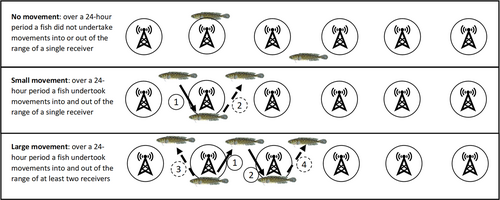
Habitat
The physical environment of the two sites was characterized by measuring environmental variables (Table 1) commonly used to quantify fish habitat (Bond & Lake 2003; Cornell et al. 2022). These variables were measured in each of the zones at each site in March 2016, towards the end of the study. Instream woody habitat (IWH; location, complexity, and size) were recorded continuously along the length of sites using a Trimble GeoExplorer XT6000 series handheld Global Navigation Satellite System (Ultimate Positioning Group Australia, Melbourne, Victoria) coupled with a laser range finder. IWH masses were defined by a measure of the complexity and size of the log or log pile. IWH complexity was measured by categorizing the number of logs (at least 10 cm in diameter) within a log pile (i.e. one trunk, two trunks, three trunks, or complex [>3 trunks]) (Kitchingman et al. 2013). The size of a log or log pile was categorized as <5, <10, <20, or >20 m2. The complexity category combined with the size category of an IWH mass provided a single measure of IWH density (Kitchingman et al. 2013). Other habitat variables were measured at 40-m intervals from the most downstream location of each site, working upstream. Stream depth (in centimeters) was included as a continuous variable and the amount of silty substrate, aquatic vegetation cover, riparian vegetation cover, longitudinal continuity of riparian vegetation, fencing (stock exclusion), and the presence of an undercut bank were each rated as low (0), medium (1), or high (2), where a higher value is more favorable to river blackfish occupancy as ascertained from our review of habitat parameters (Table 1).
| Habitat Parameter | Units | Restored Site | Control Site |
|---|---|---|---|
| Silt (substrate) smothering | Scored as <20% = 2, 20–60% = 1, >60% = 0 | 2 (2, 2) | 0 (0, 0) |
| Emergent aquatic vegetation cover | Scored as <20% = 2, 20–60% = 1, >60% = 0 | 1.83 (1, 2) | 0.17 (0, 1) |
| Riparian vegetation cover | Scored as <10% = 0, 10–25% 1, >25% = 2 | 1.67 (0, 2) | 1.17 (0, 2) |
| Longitudinal continuity of riparian vegetation | Scored as continuous = 2, semi continuous = 1, none = 0 | 1.83 (1, 2) | 1.5 (1, 2) |
| Fencing (presence) | Both banks = 2, one bank = 1, none = 0 | 1.16 (0, 2) | 1.5 (0, 2) |
| Undercut bank (presence) | Both banks = 2, one bank = 1, none = 0 | 1.17 (1, 2) | 0.17 (0, 1) |
| Water depth | cm | 29.7 (24.2, 41.2) | 37.15 (28.1, 49.05) |
| Instream woody habitat density | m3/m2 | 0.058 (0.053, 0.068) | 0.01 (0.007, 0.013) |
Statistical Analysis
Aim 1: Did Habitat Conditions Vary Between Our Treatment and Control Sites?
We addressed this aim with a summary of the different habitat variables observed at each site.
For further analyses, we used principal components analysis (PCA; “prcom” function in “base” package of R) to decompose the eight habitat parameters measured in each zone into a reduced number of dimensions that represent overall habitat value. Our PCA used a correlation matrix that scaled variables because they were measured in very different units (Table 1). The first three principal components (PC) had eigenvalues greater than 1 and explained 88.8% of the total variance (Fig. S1). These were retained as predictors for subsequent fish habitat use and movement analyses (Quinn & Keough 2002). PC1 explained 53.6% of the total variation and was negatively related to the amount of silt (loading: −0.947; 20.92% contribution), emergent aquatic vegetation (loading: −0.949; 21.00% contribution), presence of undercut banks (loading: −0.858; 17.16% contribution), and density of instream woody habitat in a zone (loading: −0.942; 20.66% contribution). PC2 explained 20.9% of the total variation and was negatively related to average water depth (loading: −0.669; 26.79% contribution), percentage riparian vegetation cover (loading: −0.808; 39.04% contribution), and degree of riparian vegetation cover continuity (loading: −0.585; 20.45% contribution). PC3 explained 14.2% of total variation and was positively related to the presence of fencing in a zone (loading: 0.782; 53.87% contribution), the degree of riparian vegetation cover continuity (loading: 0.420; 15.52% contribution), and average water depth (loading: 0.437; 16.8% contribution). For loadings and percentage contribution of each habitat parameter to the three principal components axes refer to Table S1.
Aim 2: Did Fish Remain at Translocated Sites?
Kaplan–Meier curves were used to visually examine if the probability of a fish remaining in a site differed between the treatment and control sites. We then used Cox's proportional hazards regression to model the amount of time fish were recorded in either of the two sites (treatment and control) (maximum tag life 257 days) as a function of site type. These models are ideally suited to analyze time-to-event data (i.e. time until a fish left or died) but also account for right-censoring which is where the fate of some individuals is not known at the end of the study (i.e. the fish is alive and has not left the study region). Model assumptions were checked using residual plots and Grambsch and Therneau's test for proportional hazards (Grambsch & Therneau 1994). Fish that left their site but subsequently returned were deemed to have been in the site until their last recording. The model with the lowest Akaike information criterion corrected for small sample size (AICc) (Burnham & Anderson 2002) was selected as best among candidate models. Analyses were performed using the “survival” package in R version 4.0.5 (R Development Core Team 2019).
Aim 3: Which Habitats Did Fish Use?
Habitat use was estimated by summing the number of days each individual fish spent within a given zone (excluding zones it never visited), conditional on the total number of days a fish was present in the study. We analyzed this proportional data with a series of univariate binomial generalized linear mixed models (GLMMs) to explore the importance of our three measures of habitat value (PC1, PC2, and PC3). These GLMMs included random intercepts for a unique identifier for each fish (FishID) to account for the repeated measures of habitat use within an individual fish, and an observation level random effect as models were overdispersed. Models were fit using the glmer function and competing models with variance inflation factors <3 (Zuur et al. 2009) were compared using AICc (bbmle package in R).
Aim 4: Exploring the Drivers of Fish Movement
When analyzing the movement data, we divided the treatment and control sites into areas defined by the acoustic receivers and then used the movement of fish into and out of the range of individual receivers to categorize movement (over a 24-hour period). We adopted a three-point scale to characterize a fish's movement type on a given day: no movement (if a fish did not undertake movements into or out of the range of a single receiver), small movement (when a fish undertook movements into and out of the range of a single receiver), and large movement (if a fish undertook movements into and out of the range of at least two receivers). These classifications broadly accorded with the distances river blackfish have been observed to move in previous studies (Koster & Crook 2008). We used an ordinal regression mixed model (also known as cumulative link mixed model CLMM) with a logit link function to analyze daily fish movement data. FishID was included as a random effect to account for the repeated measures nature of our data (i.e. multiple observations of daily movement per fish). Ordinal regression allows for the analysis of data where the response variable exists on an arbitrary scale and only the rank order is of interest. Predictor variables of daily movement type included: site type (treatment or control), a proxy for habitat quality (PC2, see aim 2 results), time since fish were released (1 October 2015, range: 1–258 days), and current or previous day's rainfall. River blackfish movements can coincide with increases in discharge (Koster & Crook 2008, 2017), but there is no stream flow gauging station in Coalition Creek; therefore, rainfall from the nearby rain gauge at Korumburra (www.bom.gov.au), which is located approximately 5 km from the translocation sites, was used as a surrogate for river discharge (range: 0–33.8 mm), and time since the study commenced. We also included a binary variable that characterized a fish's movement status on a previous day (lag-1; 0: no movement; 1: movement). This variable allowed for a potential Markov process in which future movement states depend on the preceding movement state (Bestley et al. 2010; Koster et al. 2018). It also accounts for temporal correlation in the data.
We built a series of increasingly complex fixed effects models that included a series of planned interactions. An interaction between site type or habitat quality (proxied by PC2) and rainfall tested whether the habitat in which a fish resided influenced its propensity to respond to rainfall. Interactions between time and site (or PC2), and time and rainfall tested whether seasonality of movement was influenced by habitat, and whether the timing of flow events was important in determining the movement response. Continuous predictor variables were scaled ([x − mean]/SD) to aid model convergence. Site type (treatment or control) and PC2, and the two rainfall variables, were modeled separately due to collinearity. All models included lag-1 to deal with autocorrelation in movement data. Models were fit using the “clmm” function in the “ordinal” package (Christensen 2019). Competing models were compared using AICc using the “dredge” function from the “MuMIn” package in R.
Results
Aim 1: Did Habitat Conditions Vary Between the Treatment and Control Sites?
There were differences in some habitat conditions between the treatment and control sites. Specifically, at the treatment site there was more silt, higher cover of emergent and riparian vegetation, more undercut banks, and a higher density of instream woody habitat (Table 1).
Aim 2: Did Fish Remain at Translocated Sites?
The Kaplan–Meier curves showed that the probability of a fish remaining in the treatment site quickly declined over the first 14 days, but then remained constant at 64% until the end of the study (Fig. 2). In comparison, 47% of fish remained in the control site. Despite these apparent site-specific differences, the best Cox's proportional hazards model included just the model intercept (ΔAICc to model including site: 2.1). This indicates that there was an equal probability of fish leaving (or staying) in each site.
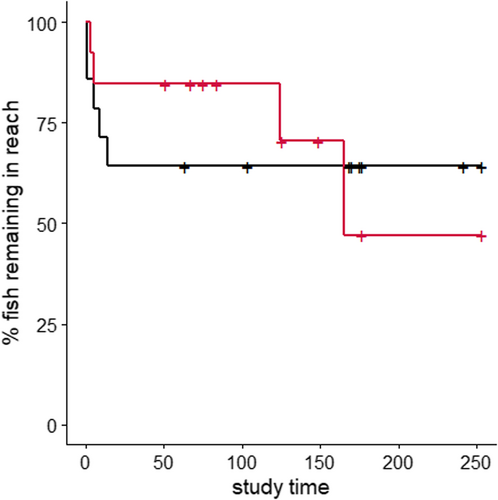
Aim 3: Which Habitats Did Fish Use?
PC2 was the best overall habitat value predicting fish habitat use (ΔAICc to PC2 model; PC1 = 7.1, PC3 = 6.6, intercept only = 5.5). Fish spent more time in zones with lower PC2 scores (Fig. 3), which were categorized by greater water depth, riparian vegetation cover and degree of riparian vegetation cover continuity (Table S1).
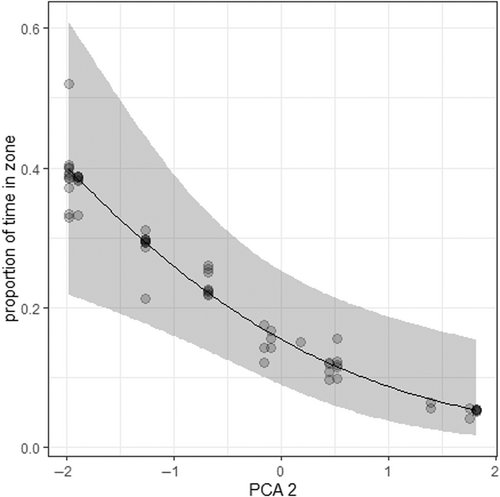
Aim 4: Exploring the Drivers of Movement
The best ordinal regression model included interactions between PC2 and current rainfall, and PC2 and time since release (ΔAICc <1.6; Table S2). This model provided a better fit to the data than those including site (ΔAICc >61) or the previous day's rainfall (ΔAICc >37, Table S2).
When a fish resided in a low-quality zone (Fig. 4, left panel), if there was no or light rainfall, only small movements (fish moved in and out of the range of a single receiver; Fig. 1) were likely, while any movement after a heavy rainfall event was likely a large movement (fish moved in and out of the range of at least two receivers). Fish residing in zones with median quality habitat (Fig. 4, middle panel) regularly made small movements irrespective of rainfall and had an increasing probability of making large movements as daily rainfall increased. Fish residing in zones with high-quality habitat (Fig. 4, right panel) had an increased probability of making small movements on higher rainfall events but had a very low probability of making a large movement, irrespective of rainfall magnitude. Overall, fish had the highest probability of making big movements when residing in zones with low-quality habitat and of not moving when residing in zones with high-quality habitat (Fig. 4).
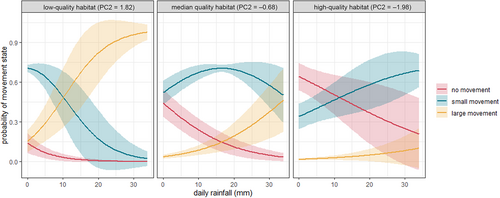
Fish were generally more likely to make small and large movements after translocation, especially when residing in zones with low-quality habitat (Fig. 5, left panel). Smaller movements were common throughout the study, although became increasingly less likely in zones with median and high-quality habitat (Fig. 5, middle and right panels). Generally, fish became more sedentary as the study progressed for all habitat qualities (Fig. 5). Fish were also most likely to move in a similar fashion to what they had done on the previous day, with the magnitude of this carryover effect greatest for fish not moving or undertaking small movements (Fig. 6).
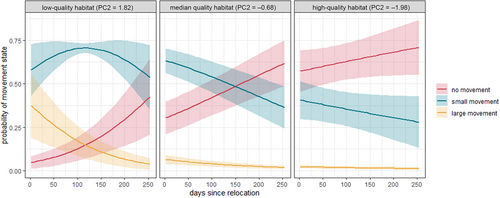
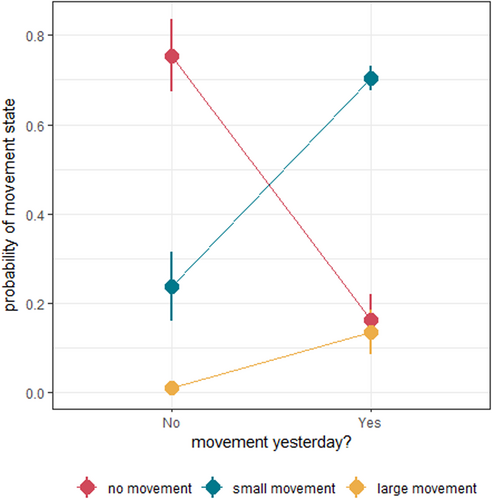
Discussion
Our results suggest river blackfish are a suitable candidate for translocations. We found that most fish remained within translocation sites for the 9-month duration of the study. We detected only two fish moving more than 1 km (between study sites), and most movements were less than 100 m. Fish also spent more time in areas characterized by greater water depth and riparian vegetation canopy cover highlighting the importance of ensuring that prospective release sites for translocated blackfish have these habitat characteristics. We also found that river blackfish were more likely to move when residing in poor-quality habitat; therefore, translocations will be more likely to succeed if fish are released into sites that already contain the habitat components they require. These findings suggest that river blackfish are retained at translocation sites at relatively high rates; therefore, this might be an effective conservation intervention.
In any translocation program, it is important to assess if the species under consideration is an appropriate candidate, including in terms of their site fidelity and motivation to return home. We found that 64% of released river blackfish remained within the treatment site and 47% within the control site for the 9-month duration of the study. While river blackfish have limited dispersal capabilities (Khan et al. 2004; Koster & Crook 2008), it was unclear if they were likely to move greater distances following translocations. In previous trials, reintroduced river blackfish returned to their original point of capture after being released 40 m upstream and downstream of their capture location (Khan et al. 2004) but our results suggest when fish are moved between locations further apart (>40 river kilometers) they are more likely to remain. Our results suggest that river blackfish, along with other less mobile species, may be more suitable candidates for translocations than more mobile species, especially when restoration has been undertaken at relatively small spatial extents. Developing a more mechanistic understanding of fish-habitat associations and how these can vary across different spatial extents can help ensure that the physical circumstances of restorations match the life history of the focal species, especially in relation to spatial scales (Hale et al. 2019b).
Our results should be considered preliminary given our relatively small samples sizes, and further trials are needed. While the percentage of released fish remaining at treatment sites was higher, the model did not identify a difference in the probability of fish leaving the treatment and control sites, likely due to low statistical power. Ideally future trials would incorporate both increased numbers of fish and replicate treatment and control release sites. Similar to other translocation programs, increasing the number of individuals that can be moved without compromising source populations is challenging, particularly in some areas where abundance and distribution of the species is low compared to previously. Translocations need to be carefully planned, and consider appropriate source populations (i.e. one vs. multiple, hatchery vs. wild) both in terms of sourcing appropriate numbers of individuals and ensuring individuals are suited to translocation sites (e.g. through ancestry or environment matching, or to maximize adaptive potential) (Houde et al. 2015). It will also be important to consider consequences of removing fish from particular locations for translocations in the context of other threats that they also face, such as by balancing the allocation of harvest for translocations and recreational angling. Ideally, longer-term monitoring should be included to assess breeding and recruitment to determine if restoration actions can lead to self-sustaining populations, a measure of restoration success (IUCN/SSC 2013; Robert et al. 2015).
Fish spent more time in areas characterized by greater water depth and riparian vegetation canopy cover (PC2) in both the treatment and control sites. Previous work has shown that river blackfish are more often found in deeper water (>20 cm), and in sites with complex instream habitat (Koehn et al. 1994; Khan et al. 2004; Koster & Crook 2008). Increased abundances of juvenile river blackfish after additions of woody debris into streams have also been observed (Howson et al. 2012). These results highlight the importance of ensuring that prospective release sites for translocated river blackfish either have these habitat characteristics, or interventions can be undertaken to provide them, before fish are released.
One of the main reasons translocations fail is that individuals move away from release locations (Le Gouar et al. 2012). These post-release movements can be in response to intrinsic factors, release conditions, and social behavior but the relative importance of these factors is not often considered (Garnier et al. 2021). We found that river blackfish were more likely to move when translocated into poor-quality habitat, which aligns with other observations that fish movement is often lower in higher-quality or complex habitats than in poorer-quality or homogenized habitats. For example, red-tailed barbel (Barbus haasi) moved less in sites with greater depth, slower current, and more cover compared with shallower, exposed sections in a Mediterranean stream (Aparicio & De Sostoa 1999). Higher-quality or complex habitats are thought to have higher probabilities of meeting the resource needs of individuals, and thus can be associated with reduced movement behavior (Albanese et al. 2004; Rasmussen & Belk 2017) but not always (Roni & Quinn 2001). Therefore, translocations will be more likely to succeed if fish are released into sites that already contain the habitat components they require, or if these habitats are subject to successful habitat rehabilitation before release. It is well known that release habitat quality is one of the main predictors of translocation outcomes but many translocations are compromised because animals are released into low-quality habitat, either because it was erroneously assumed to be high quality before release, deteriorated in quality post-release, or no other locations were available (Berger-Tal et al. 2020). While understanding and managing the quality of prospective release sites is a general recommendations in translocation projects (IUCN/SSC 2013), it is important to have evidence to support this principle for each individual translocation especially given as managers often lack this information to guide decision (e.g. in 20% of projects assessed in a recent review of difficulties in translocations; Berger-Tal et al. 2020).
River blackfish were more likely to move from poorer-quality habitats when large rainfall events occurred. Our observations are consistent with previous work that has shown that river blackfish can undertake larger movements away from established locations to new areas that coincide with increased flows (Koster & Crook 2017). This result highlights the importance of understanding and managing flows in conjunction with habitat rehabilitation and translocations. Without doing so, environmental flow releases could potentially trigger movements away from release (and rehabilitated) sites. This highlights the need to consider the potential trade-offs in determining the most effective strategy, noting that the options that give best outcomes for entire populations may be sub-optimal for individual species or taxonomic groups (Tonkin et al. 2021).
To improve the conservation outcomes of river blackfish, there is a need for further management investment. High priorities are to examine the feasibility of, and then undertake, translocations in other areas, with appropriate monitoring to assess progress, coupled with interventions to create suitable habitat, particularly instream and riparian interventions. Captive breeding guided by genetics may also be required to facilitate reestablishment of this species using an integrated program incorporating waterway rehabilitation and fisheries management (Lyon et al. 2012).
Habitat restoration and translocations are often undertaken by management agencies with the best intentions but with a history of failure (Berger-Tal et al. 2020). Our study highlights the importance of considering habitat use and movement ecology in future translocations for river blackfish and other nonmigratory fish species. In particular, it is critical that translocation and restoration programs are informed by knowledge of the candidate species habitat requirements, and the drivers of movement. By better understanding these factors, we can hopefully increase the likelihood that translocation and restoration programs achieve their intended biodiversity outcomes.
Acknowledgments
This project was funded by the Victorian Government using revenue raised from the sale of Victorian Recreational Fishing Licenses. The authors thank E. Keogh and K. Williams (WGCMA) who commissioned the project. L. Dodd and J. Mahoney are thanked for their assistance with fieldwork, as are R. Drury, E. Bickel, and other members from Leongatha Angling Club who contributed to site selection. Special thanks to various private landowners who allowed us access to sites on their properties. This work was conducted under Fisheries (and translocation) Permit No. RP827 and DELWP Animal Ethics Permit No. 15/19. The authors thank S. Raymond for earlier comments on this manuscript and three anonymous reviewers for feedback that improved the manuscript.



